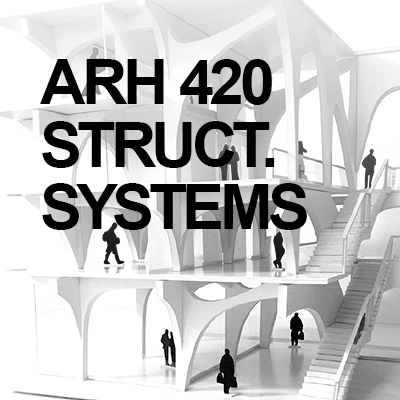
ARH 420 Structures: Systems Investigation
Develop your structural intuition by breaking physical models. Working with a structural engineer and an architect, you will invent a structural system for your studio project that is integral to the architectural design identity and compare structural behaviors of different building geometries using load path diagrams. You must take this course concurrently with ARH 410.
Prerequisites: ARH 350, ARH 410, either ARH 320 or ARH 330 (ARH 410 must be concurrent)
Course Learning Outcomes
- Develop structural intuition to visualize structural behaviors using physical model load tests and load path diagrams
- Evolve and adapt structural systems to accommodate programmatic and spatial criteria by identifying, defending, and resolving irregularities in common structural systems
- Research principles of structural behavior in withstanding gravity and lateral forces in contemporary structural systems
- Critique precedent buildings in terms of their structural expressiveness and the relationship between structural efficiency and architectural form
- Assign different density and thickness to structural elements so that matter is organized in response to force
- Assign stereotomic or tectonic materiality to structural elements consistent with architectural design concept
- Propose structural load paths that reinforce the architectural design concept
- Determine structural modules based on understanding of span limits for different structural systems that best accommodate program needs
- Explain decision making process of structural system selection and adaptation through diagrams and annotations
- Acquire vocabulary for structural elements and their behaviors
NAAB Criteria
- This course addresses part of NAAB SC.4 Technical Knowledge (Understanding) How the program ensures that students understand the established and emerging systems, technologies, and assemblies of building construction, and the methods and criteria architects use to assess those technologies against the design, economics, and performance objectives of projects.
Develop your structural intuition by breaking physical models. Working with a structural engineer and an architect, you will invent a structural system for your studio project that is integral to the architectural design identity, and compare structural behaviors of different building geometries using load path diagrams. You must take this course concurrently with ARH 410.
Architects collaborate with structural engineers in the design of buildings. For this collaboration to be successful it is important for architects to cultivate an intuitive sense of how building structures behave. We will develop structural intuition through load testing physical models and making careful observations. Structural design this semester will aspire towards a close integration with architecture. A clear architectural design intent and an open-mindedness for inventive structural systems are the necessary ingredients for a meaningful integration. When structural design is approached as an architectural design opportunity, rather than as a restriction on design freedom, compelling and rigorous design proposals will follow. Grounded in a critique of prevalent contemporary structural systems, we will explore and experiment with creating conditional rules for structural behaviors to invent new structural systems.
Our goal this semester is to integrate the architectural design intent with the structural solution. The structural proposal will be uniquely adapted to the architectural studio project. In other words, the structural proposal will not be one that is generic. To this end, we will actively seek to create a structural problem. The presence of a structural problem in your project is a good litmus test for the integration.
Constraints make better design. For this reason, the competing design criteria between architecture and structure is welcomed in this class. The negotiation and compromise that must happen to reconcile the competing priorities is what we refer to as the integration between architecture and structure, our goal.
